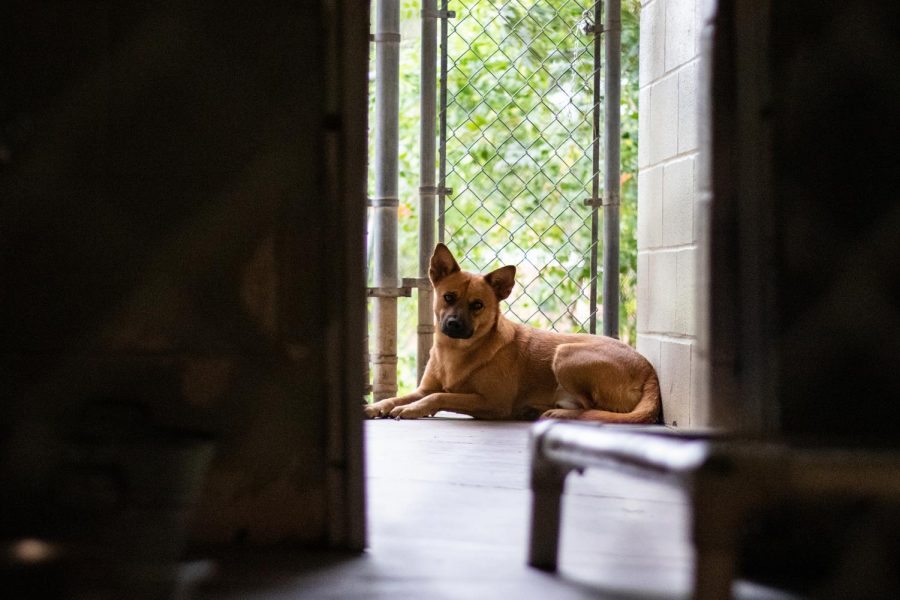Adopt, don’t shop
Rescuing an animal from your local shelter is saving a life
September 10, 2019
Animals unwanted, dumped on the side of the road. Animals abused, pitted against each other in cruel gambling rings. Animals displaced, ripped from their families by tragic natural disasters. Countless animals without a voice and without a home are waiting to find the family they need, and you can help them.
Adopting or fostering shelter pets, as well as neutering or spaying your pets, is imperative. 6.5 million animals are taken in by shelters each year. Out of those 6.5 million, nearly 25% of them won’t ever know what it’s like to be a part of a loving family because they are euthanized before they get the chance. If you are able to, rescue a pet and save a life.
“It’s a crisis at this point,” said Bertha Curry, Office Manager of The Animal Care and Adoption Center. “If we get 200 animals in the shelter per month, then it’s a crisis.”
While some dogs are reclaimed, the majority go to the adoption floor. Some animals are at the shelter for months. Luckily, adoption is not the only way to help the countless dogs that come into the custody of the shelters. There are many ways you can help if you are unable to adopt.
“[People who want to help] can come up here and volunteer. They can also bring blankets, sheets, pillows, torn towels or detergent to wash the clothes,” Curry said. “They can also bring dog food, toys for the dogs, treats. Just as if you had your own dog.”
There is another way you can indirectly help animal shelters. Getting your pets spayed and neutered could help greatly reduce shelter intake.
“People should realize if you come and adopt a dog, please get it spayed and neutered. That’s our problem,” Curry said. “Too many dogs I hear are not spayed or neutered, and all they’re doing is producing babies after babies.”
If you can’t afford the cost of having your pet sterilized, there are options available to help you.
“If you have a dog and it is not spayed or neutered, there is help out there to help you. Get that dog spayed or neutered,” Curry said. “There are so many different programs out there where you can just pay half of it, or they’ll just pay all of it.”
Another cause of so many animals ending up in shelters is people leaving their pets on the side of the road and driving off. Often times this happens because a person feels it is their last resort, but it should never be. It’s cruel to the animals and harmful to the ecosystem, especially if that animal has not been spayed or neutered.
Sometimes, instead of abandoning animals on the side of the road, people will take animals directly to the shelter to surrender them. While slightly more humane to the animal, it should still not be something you resort to.
“[Monday] I had five dogs come in and three cats from citizens,” Curry said. “I’ll usually ask them if they have relatives that might want to take it. ‘Have you talked to different rescue groups?’ And sometimes I can get them to where they’ll hold on to the dog until I find a rescue group that can come and take it from them.”
Seeing all the animals placed in shelters due to carelessness or neglect can be hard to stomach. There are so many animals in need of a home that it is jarring, even to those who have worked with the shelter for years.
“I feel really sad, and we try hard here at the shelter to get our dogs adopted,” Curry said. “Our goal here is to have three dogs adopted a day. We meet that goal sometimes, and the majority of the time we don’t.”
While many aspects of animal shelters can be saddening, there is also a joy that comes from seeing an animal be united with a person. Seeing an animal finally go to its new and loving home can be a powerful and emotional moment.
“My favorite thing about working here is getting the dogs adopted,” Curry said. “Sometimes I cry because the dog could’ve been here for months and finally that baby is going to a good family.”
Bringing home a shelter animal is safe. You cannot adopt a dangerous dog. The shelter does not put out sick or aggressive animals for adoption, so that should not be a concern when considering adoption.
“We only euthanize if they are sick to where we cannot help them or if they are aggressive. You cannot adopt an aggressive dog out,” Curry said. “They’re all very sweet. If they’re not sweet, they won’t make it to the adoption floor.”
Even at the shelter, you can see the sweetness of the dogs. They all come up to lick you through their kennel, wagging their tail, or they’ll smile and sit as you come by to pet them. All the dogs in the shelter just want to be brought into a loving family.
“You know, you get some dogs that just smile at you. You get some dogs that just sit there, and you can tell that they are lap babies. That’s how you can tell the difference between a dog that’s been out in the world, just wandering, versus a dog that was just put out due to the fact of their situation,” Curry said. “Because the dogs are still just the same way, they want to be cuddled. We get dogs that know how to fetch. My favorite is when they sit there and they’re looking at you and they just put their hand out. You know they want to shake.”
















